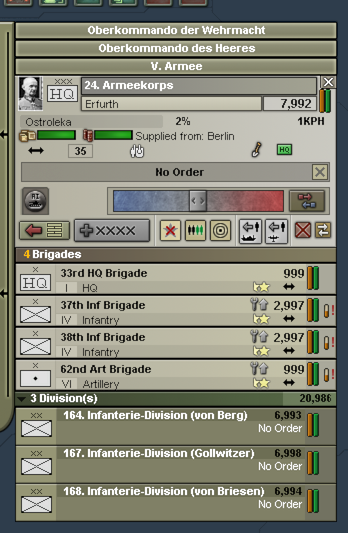Hi guys, it's me again. I decided to abandon the previous game I posted about some days ago because it became obvious that my fate in the long run would have been the same as real life germany in ww2.
Now, the objectives of this run are the same as the previous one: basically conquer europe, the Soviet union and the United Kingdom. If I succeed, I'll look into invading the US, but that's a stretch since I'm a new player. (Well technically I'm not but I didn't really learn much 10 years ago when I was 13).
I know the initial set up is crucial so I have some questions.
Diplomacy: I set automated trade cause I don't have the patience to micro it.( I micro everything else). Who should I influence?
Production: lots of artillery brigades to strengthen my existing 3 INF divisions. This will be the backbone of the army. Apart from this, how many tanks and motorized should I build? How many planes and which kind? How many ships ?(keep in mind I want to beat the US, so I think I'll need a big navy). I was thinking about building a bunch of SH BB with DDs in order to have something strong without the need to invest in researching BB tech, and then carriers with CL.
Also, some ideas for divisions?
Intelligence: I'm building up my spy population in order to get 10 in Germany, then I'll send some in the Soviet Union to lower their national unity since game start, and some more in the other allies countries just to see what's going on industry wise.
Technology: this game I'll start researching nuclear since 1939, and I'd also like to research v2 rockets and jet engines just for the sake of it (they seem so cool).
What are the most important technologies I must research ASAP that newbies don't know about?
Thanks to whoever is going to help me out, I love the game I'd like to learn how to play the best I can.
So you want to conquer Europe, the Soviet Union, and the UK. In addition, you wish to defeat the US navy (you aren't unsure if you are up to the task of invading them).
Here is my advice for you.
First off, go to the Politics tab. You have 10 government positions: Head of State, Head of Government, Foreign Minister, Armament Minister, Minister of Security, Head of Intelligence, Chief of Staff, Chief of the Army, Chief of the Navy, and Chief of the Air force.
For Germany, the Head of State won't change. He gives you +5% to espionage bonus (according to the wiki, The Espionage Bonus trait is an increase in the accuracy of all information presented on the Intelligence screen) and -10% to National Unity Changes (it makes it takes longer to increase the national unity of the county).
The Head of Government is Rudolf Hess, and he will eventually be replaced by an event (I believe in 1941). He gets replaced by Martin Bormann, another Nationalist Socialist that also provides +5% to IC.
We now move onto the Foreign Minister. The current Foreign Minister is Constantin von Neurath. He is a Fascist while Germany is controlled by the Nationalist Socialist Party. Replace him with Joseph Goebbels, a Nationalist Socialist. Their traits don't matter, as Germany is part of a faction.
I'm going to go on a tangent for a moment. On the right hand side of the politics screen is the popularity of the each party that exists within the nation. As the National Socialist party is very popular, they are entitled to 7 cabinet positions (The Head of State and Head of Government don't count toward that number).
The DVP (Social Conservatives) are entitled to 1 seat, but Germany gets no Social Conservatives in 1936.
If there is a miss match between the number of seats a party is entitled to and the number of seats the party actually controls, you will get the negative modify of fractured government. It slowly decreases your national unity by 0.001% each day. Because of this very small affect, it is best not to worry about it. When it comes to ministers, pick the one that has the best trait for whatever your goal is. However, if you have two ministers that have the same trait or their trait doesn't matter, then pick the one that gets you closer to what each party is entitled to.
With that tangent over, we will now go back to the left-hand side of the screen where all the ministers are.
The next positions we will focus on is the Armament Minister.
This is the first time we can not only replace a Minister, but their trait actually matters.
You have 13 Ministers you can choose from:
Rudoff Hess: (-20% to Aeronautical Engineering Decay and -5% to Heavy Aircraft Practical Decay)
Werner Von Blomberg: (-25% to Infantry Theory Decay and -25% to Militia Theory Decay)
Hermann Goring: (-20% to Aeronautical Engineering Decay and -5% Light Aircraft Practical Decay)
Hjalmar Schacht: (+10% IC)
Franz Xavier-Schwarz: (+5% to resources and -25% to Chemical Engineering Decay)
Robert Ley: (-10% to supplies, and +10% to Ruling Party Support)
Frtiz Thyssen: (-2.5% to Consumer goods during wartime, and -2.5% to Consumer goods during peace time)
Julius Curtius: (+5% to resources and -25% to Chemical Engineering Decay)
Alfred Hugenberg: (+5% to resources and -25% to Chemical Engineering Decay)
Franz Xaver Ritter Von Epp: (-25% to Infantry Theory Decay and -25% to Militia Theory Decay)
Franz Seldte: (+20% to supplies)
Konstaintin Hierl: (+5% to resources and -25% to Chemical Engineering Decay)
Gustav Krupp: (-25% to Mobile Unit Theory Decay and -25% to Automotive Theory Decay)
There are a lot of Ministers, but some are redundant or downright bad. Werner Von Blomberg and Franz Xaver Ritter von Epp both have the same trait (-25% to Infantry Theory Decay and -25% to Militia Theory Decay) and are both from the same party (National Socialist). Franz Xavier-Schwarz, Julius Curtius, Alfred Hugenberg, and Konstainstin Hierl all have the same trait (+5% to resources and -25% to Chemical Engineering Decay). Franz Xavier-Schwarz and Konstainstin Hierl and both National Socialist, and Julius Curtius and Alred Hugenberg are both DNVP (Paternal Autocrat). Robert Ley's trait (-10% to supplies, and +10% to Ruling Party Support) is outright bad, because it increases the IC cost for supplies.
We will now focus on the Ministers that affect IC: Hjalmar Schacht: (+10% IC), Frtiz Thyssen: (-2.5% to Consumer goods during wartime, and -2.5% to Consumer goods during peace time), and Franz Seldte: (+20% to supplies).
In order to talk about these 3 Ministers, we need to go to the Production tab. On Jan 1st, 1936 Germany's Base IC is 144 and their Available IC is 201.
They are spending 12.29 IC into supplies, and 12.86 IC into Consumer Goods. Hjalmar increases the available IC from 201 to 216 IC, but consumer goods increase from 12.86 IC to 13.39 IC. Frtiz Thysseen decreases consumer goods IC from 12.86 IC to 7.84 IC. Franz Seldte decreases IC for supplies from 12.29 to 10.53 IC.
Between all three of them, Hjalmar is the best option. Sure, consumer goods increase slightly and more IC the player has, the more resources they need, but its a small price to pay. On top of that, the player can decrease their consumer goods by getting rid of all HQs besides the theater HQ (you will rebuilding them all sometime in Jan of 1939 well in advance of your war with Poland), but you will decrease your consumer goods by decreasing your neutrality. In terms Franz Seldte with increasing supplies by +20%, the player can decrease consumption of supplies by including as many Generals with the trait Logistic Wizard (decrease consumption of supplies by -25%). The player can also decrease supply consumption by having a General with a high level in Army Group, maxing out infrastructure in the provinces, researching Supply Transportation (-0.01 to Transfer Cost), Supply Organisation (+10% to Supply Throughput), Large Front (-0.01 to HQ Supply Consumption), and Guerrilla Warfare (-0.01 to HQ Supply Consumption). You can also research Supply Production (+5% to Supply Production), which decreases the amount of IC needed to produce the same amount of supplies. You should also, from Jan 1936 to Jan 1939, move most of your units to the capital, so decrease the cost of transferring supplies (make sure you trigger the Re-occupation of the Rhineland before you send all your troops to the capital). Finally, there are Ministers you can get that will better help with supply, but we will get to that later.
For these Ministers who have the trait to decrease the Decay of Theory or Practical, there is a bug. You need to get that fixed.
Rudoff Hess: (-20% to Aeronautical Engineering Decay and -5% to Heavy Aircraft Practical Decay)
Werner Von Blomberg: (-25% to Infantry Theory Decay and -25% to Militia Theory Decay)
Hermann Goring: (-20% to Aeronautical Engineering Decay and -5% Light Aircraft Practical Decay)
Franz Xavier-Schwarz: (+5% to resources and -25% to Chemical Engineering Decay)
Franz Xaver Ritter Von Epp: (-25% to Infantry Theory Decay and -25% to Militia Theory Decay)
Gustav Krupp: (-25% to Mobile Unit Theory Decay and -25% to Automotive Theory Decay).
Hello all, I started playing HoI3 again and I couldn't help but notice that the traits of my ministers seem to not work properly. As Canada my Chief of the Navy gives -25% Destroyer Practical decay and yet my Destroyer practical decayed at the...

forum.paradoxplaza.com
After you get that fixed, then we can go further into the Ministers.



